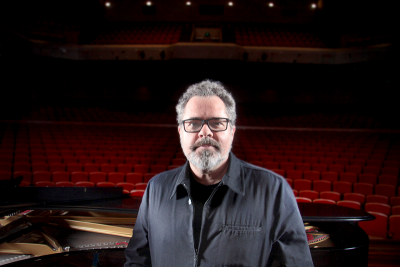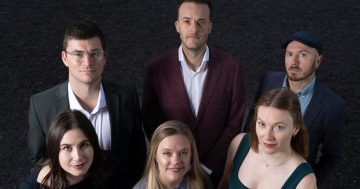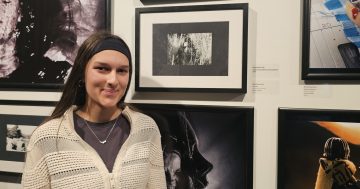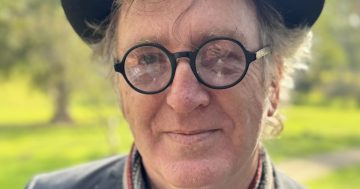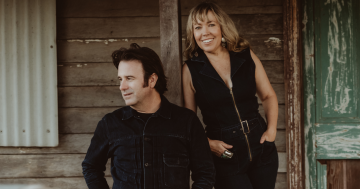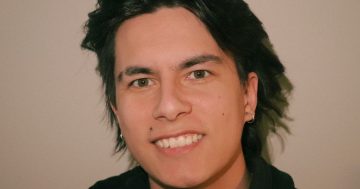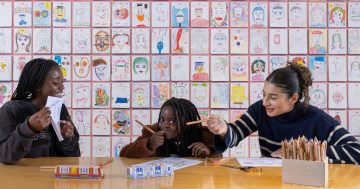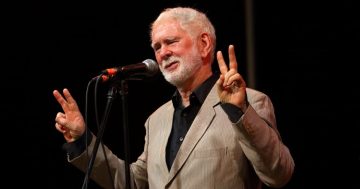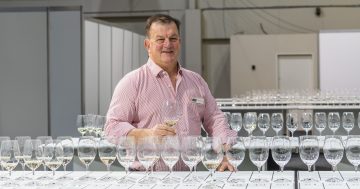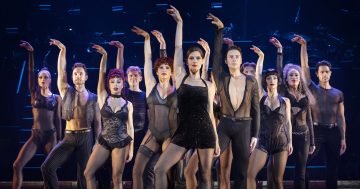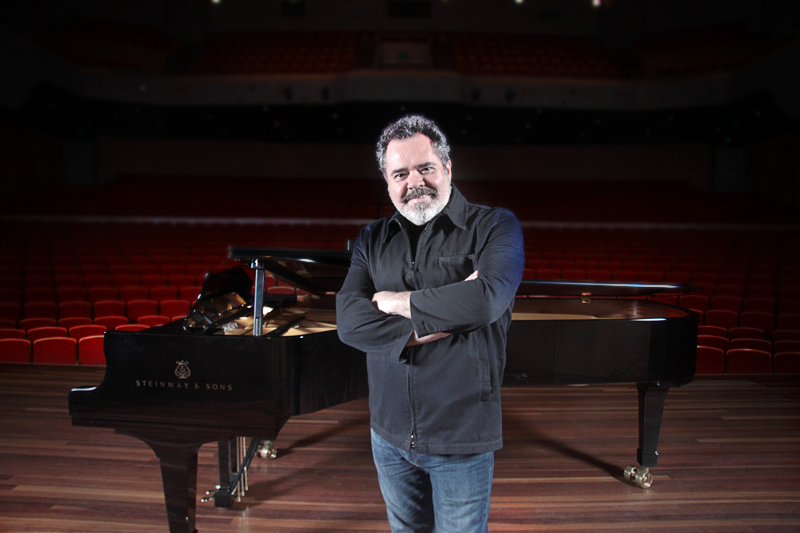
I recently hurt myself answering the trivia question “which iconic Australian band did the three Farris brothers play in?” Much to the surprise of my trivia comrades, the sudden burst of energy and athleticism triggered by this question was unprecedented. With great gusto, I leapt out of my chair and threw my body across the Hellenic Club table to clutch the keno pencil which would scribe on the answer sheet the name of the band that were the soundtrack to my formative years. Just four letters which spanned the decades between my single-digit years on this earth, to my now 30 plus years navigating this mortal coil. I-N-X-S. I sat back down, exhaled, and felt pretty chuffed with myself. As the adrenalin wore off, I let out a small whimper and uttered the words “I think I did my back”.
Six days, and several physio sessions later, I find myself sitting in the Larry Sitsky Recital Room at the ANU’s School of Music (SOM), in the esteemed company of a Farriss Brother–Canberra is full of synchronous moments like these. SOM is hosting an event to introduce Canberra to their newest recruit: Andrew Farriss in conversation: A global music career. In a Parkinson flavoured event, Andrew Farriss speaks to (Acting) Head of School Samantha Bennett about his new position as the H.C. Coomb Fellow, also giving a rare insight into his life and career as songwriter, keyboardist and backing vocalist with INXS.
During the evening, whilst sipping champagne and still basking in the afterglow of my painful trivia glory, I re-live my lifelong appreciation of this band whose international success has largely been due to the songs penned by Andrew Farriss–songs that catapulted INXS from the sticky floors of the Australian pub scene to the international festival circuit in the UK and USA.
Sitting in front of biographical images projected onto a screen behind him, Farriss shares anecdotes such as the humble beginnings of the hit song Need you Tonight, the first single from 1987’s Kick album. Apparently the song came to him just as he was about to jump in a taxi on his way to the airport to fly to Hong Kong for a song writing sabbatical with Michael Hutchence. As his creative juices flowed, so too did the taxi metre–58 dollars later and he had put down on tape what would become one of the most recognisable riffs in Australian music.
Yes, granted, Need You Tonight reached the lofty heights of Number One on the American Billboard Charts, but in my opinion, the greatest peak this song straddled was the day in 1987 when it emanated from the radio of a beige hand-held Casio keyboard, in a suburban Sydney backyard. That day, my older sister introduced me to INXS and I have idolised her ever since. She was the first ‘fan’ of music I ever knew and INXS was the first band we shared.
The first live note I heard in my life came from the keyboard of Andrew Farriss. It was the intro to the opening song Kick, from the 1988 tour of the same name. It was an October evening in 1988 and I was eight years old. I still remember what I was wearing–a fetching pair of culottes my Nanna had sewn for me, and my school shoes which dad said would ‘have to do’ if we were to make it to the Sydney Entertainment Centre on time. The next morning I stood in front of Mrs Locke’s Grade Four class, regaling the masses with the details of the night before–all while my torn ticket stub was being passed around for ‘show and tell’. 30 years later, when I meet music fans, I always ask them what their first concert was, just so I can tell them mine was INXS.
If you were to ask Andrew Farriss that question, he would tell you The Beatles. He was around eight years old, and on a trip to the UK to meet his grandparents. Hearing him speak to Samantha Bennett about his experience of seeing John Lennon and Paul McCartney live, it occurs to me that INXS are my Beatles. Needless to say then, when I get the opportunity to interview Andrew Farriss for This is Canberra, I jump at the chance. This time however, before engaging in another INXS infused burst of energy, I do my warm-up stretches first.
On the morning of the interview, he lets me know that he has just finished collecting firewood. Just as I wonder to what degree the duty statement of a visiting fellow has expanded to include such hands-on work, he advises me that he has been taking some time-out on his rural property, north of Sydney. He is keen to talk about his fellowship at ANU and his move to Canberra and is quick to confess that when he received the invitation to be the H.C. Coombs fellow for 2015, he initially didn’t understand exactly what it was. “I did a bit more research and the moment I saw some of the names that I was put with, some pretty amazing Australian arts related people, I was really quite flattered.”
Sidney Nolan and Arthur Boyd are two of the artists with whom he now shares this historical space as a distinguished artist in residence. The Fellowship, which supports creative artists in music, literature and visual art, will provide Canberra’s up and coming young musicians the opportunity to be mentored by someone who has been there before them.
Farriss reflects that “there is no use having a platinum album if you don’t have the life to hang it on,” and the move to Canberra is all part of this philosophy. “As I step into this role, not only do I feel really fortunate to be here, but I am beginning to realise that the contribution I can give is just experience, knowledge, and the things I have learnt at the coalface of a very difficult industry around the world. I see it as both a challenge and a source of me giving back.”
When he thinks about his own children and the next generation of music-makers (not, he points out, manufactured musicians), he says that the first rule is to “encourage creativity–not limit it.” He remembers his own music tuition as being somewhat unorthodox. “I think people can be misunderstood when they want to be creative, and I think for a lot of creative people, they are unorthodox. Sometimes you can get so much more out of experimentation and improvisation and going into places which are unorthodox can lead to some really amazing areas.”
He tells me his mother Jill introduced him to a Japanese lady as a young boy, who would sit with him and teach him about chords and how they all go together. The significance of this human relationship built around harmony and disharmony has stayed with him in the re-telling. Looking back on his life and his own beginnings as a music-maker, I wonder what he hopes his students will be thinking about in 20 years’ time when they are reflecting on their time with him at SOM. He thinks about this for a moment and says “I heard a saying once, that advice is something best kept brief.”
Farriss describes himself as a songwriter and a support person, and recognises that “everybody is an individual, and everybody has a slightly different take on things, and different needs.” The longer he is at SOM, the more he is able to “zero in on the individuals as much as the groups of students, and what it is they are trying to achieve.” If there were one thing he hopes that he can bring to his position at SOM, it would have to be his creative influence.
The creative area is mainly where he has come from, so he can recognise it in other people. “Sometimes creativity is like lukewarm water, and other times it is a burning hot fire,” he says. I can hear the depth of feeling that comes with this statement. It is obvious to me that that his passion is another contribution he will make to SOM and I have a feeling that this will be contagious to those young artists he collaborates with.
I’m keen to ask him about his first impressions of the Canberra music scene and its potential for local musicians. I speak to him about the recent fate of some of the live music venues in Canberra and the local community rallying to raise them from the ashes. “Talking about live venues and live music performance is so important. It always has been.” He hopes the local scene in Canberra will continue to grow and be nurtured by people “for all the right reasons, and for the next generation to showcase their talent.” Interestingly, he asks me how I would summarise the Canberra music scene. Is this a test? Using more words than I probably need to, I articulate my point that in the end it is ‘community driven.’
So is this enough to keep the music scene alive in Canberra? “There is a live scene which is more energetic in Canberra, and community based. And I think it is really cool,” he responds. “It has an embryonic feel to it that could grow into something much, much bigger. Live performance, in a community-based concept is a really important thing because you can get a school of thought that comes out of people doing that. That’s where you get major movement change. When you get people playing live, that is what creates a scene. And people get excited by that scene, and want to be a part of it, and it builds, and people keep doing it in the same area. I think that there is a lot of possibility there, and a lot of positivity. I think it could potentially be a very exciting time over the next 10, 15, 20 years, in Canberra musically. I believe that.”
Farriss’s involvement with Canberra feels as though it has come at a good time, an opportunity for him and his family to look to the future. “Getting out of Sydney, which is where we were at the time, and to get into a new thing, I began to realise that we had made a really good decision in moving to Canberra. Canberra itself is a very interesting place.” Easing their way into becoming Canberra locals, he and wife Marley have taken in some of the more iconic sites such as the museums, the Arboretum, and the National Gallery.
“Canberra has clean air, and low density traffic,” he enthuses. “It is very green around the city–I never knew that before we started exploring the area. Canberra has kept a lot of its bush identity, and what we have been enjoying about Canberra is that culturally, there is so much more to this city than you could ever really find out quickly. I am already discovering that. Because Canberra is always associated with politics, sometimes this overrides the fact that Canberra is actually a really beautiful city.” Andrew Farriss has no regrets and says he is exactly where he is meant to be, and for now, that is Canberra.
ANU will be holding a concert on October 24, 2015 at Llewelyn Hall to mark 50 years of the School of Music, showcasing some of the local talent that Andrew Farriss will be supporting during his fellowship.


